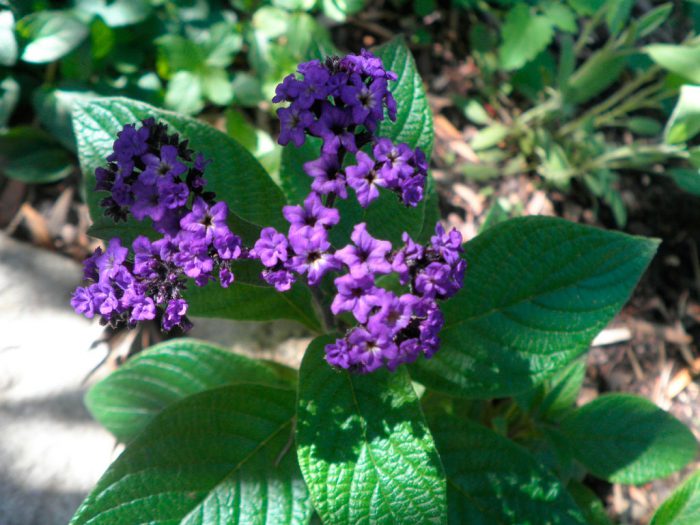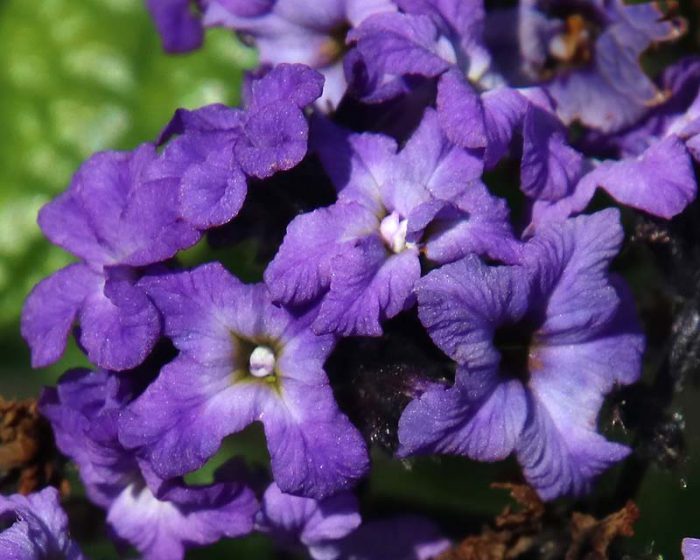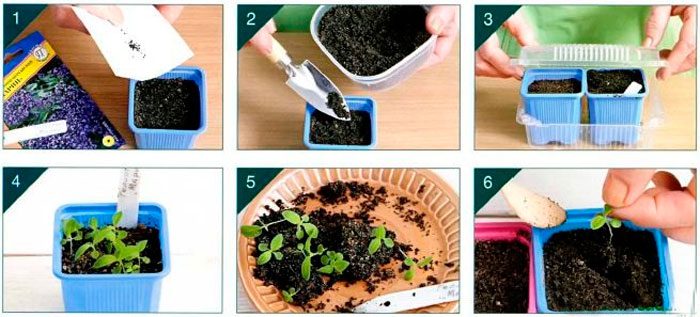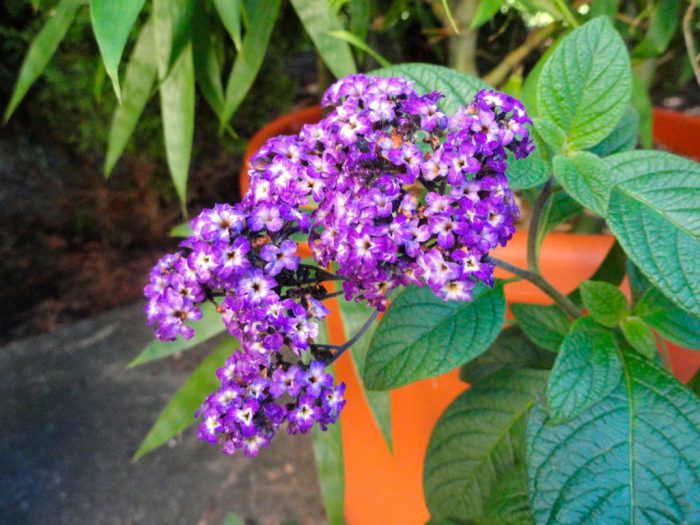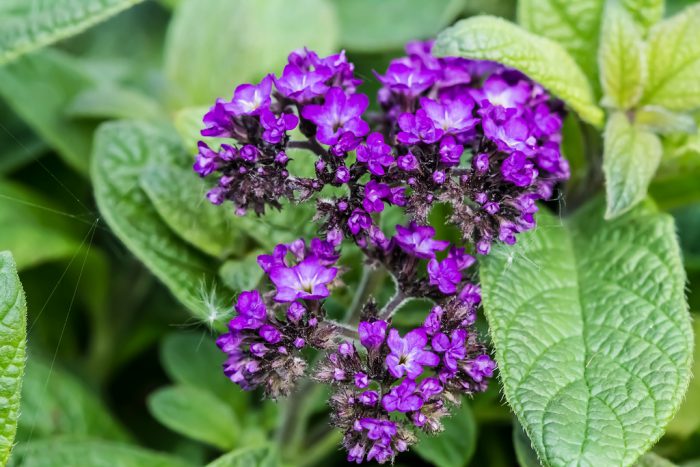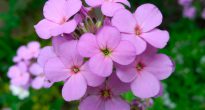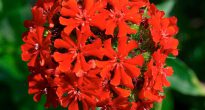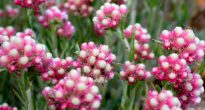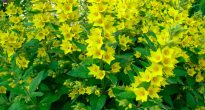Heliotrope (Heliotropium) is directly related to the borage family. This genus unites about 300 species of various plants. It is represented by perennial herbaceous plants and shrubs. In nature, they can be found in the subtropics, tropics, and also in the temperate zone of America and the Mediterranean. The name of the flower is formed from 2 words of the Greek language, which translate as "sun" and "turn, rotation". This is due to the fact that the flowers turn in the direction of the sun.
Heliotrope gained popularity as a garden plant as early as the 18th century due to its very pleasant vanilla aroma. The people call such a plant "dye litmus" and "lichen grass", in England it is called "cherry pie", in France - "grass of love", and in Germany - "grass of God". This plant has found application not only as a garden plant, but it is widely used in perfumery, as well as in medicine. But in order to get a spectacular, fragrant bush in your garden, you need to learn how to properly care for such a plant.
Content
Flowering features
Any of the species of this plant has dark green pubescent leaves, alternate, obovate. Short-petiolate leaves can be wrinkled or wavy. Small fragrant flowers are dark blue or purple, and they are collected in fluffy shields. These flowers contain a valuable essential oil, and it is this oil that is widely used in the perfumery industry to this day. However, it should be borne in mind that there are species in the shoots of which there is a poisonous alkaloid called cinoglossin, while the seeds contain laziocarpine. These substances have a paralyzing effect on the central nervous system of the human body, as well as animals. However, as a rule, such species are not grown as horticultural crops.
Each flower stalk blooms for about 4 weeks. After flowering, fruits (coenobium) are formed, which, after ripening, are divided into 4 parts (erems). Each of the parts contains small plant seeds. In favorable climatic conditions, heliotrope is grown as a perennial, but in mid-latitudes with frosty winters it is grown as an annual.
Growing from seeds in the open field
Sowing
Anyone who decides to grow such a flower from seeds should remember that the choice of planting material should be taken with full responsibility. You need to buy seeds only in a good specialty store, while preference should be given to such proven brands as: Prestige, Search, Johnsons or Unwins Seeds, because they can guarantee high quality and good quality seeds. In the event that the planting material is of good quality, then flowering from the moment the seedling appears will occur in 3-4 months. If you decide to sow self-collected seeds, then you need to be prepared for the fact that their germination is rather poor, such plants bloom only at the end of the summer period, the bushes themselves can be of different heights, and their inflorescences are smaller than usual.
Sowing seedlings
Sowing seeds for seedlings is necessary at the end of winter and early spring. An earth mixture consisting of peat and sand (4: 1) must be thoroughly steamed to exclude the possibility of contamination of seeds with various fungal infections. Pour the prepared soil mixture into the container and compact it with a plank. After that, you can start sowing, for this you need to evenly distribute the seeds on the surface of the substrate, and then sprinkle them on top with the same mixture, while the layer should be 0.1-0.2 centimeters, but not more. The container on top must be covered with glass or film, and then it must be placed in a warm place (from 18 to 20 degrees). After the seedlings appear, about 5–20 days after sowing, you need to remove the glass from the container, and rearrange it on the windowsill. The temperature should be slightly raised to 20-22 degrees. At the same time, bright lighting is not required for seedlings, since they grow and develop well without this.
Seedling
When the seedlings grow 2 true leaves, they will need to be dived. They are seated in separate pots with a nine-centimeter diameter, while filling them with the same earth mixture. After the transplant, the seedlings must be watered. Half a month after the pick, you should feed the young plants. For this, fertilizer is used for seedlings.
Landing
This flower should be transplanted into open ground in early summer, when the threat of frost at night has passed. A place suitable for heliotrope should be sunny, and the soil should be loose, well-permeable to water, enriched with nutrients, and also containing a large amount of humus.
Pour leaf and manure humus into the prepared hole. After that, you need to carefully transfer the flower into it and cover it with ordinary garden soil. The soil is squeezed near the plant, and then watering is carried out.
Correct care
Growing
In order for the plant to grow and develop normally, the correct watering regime is needed. Water it only when necessary; in dry weather, watering will be more frequent. When the plant is watered, then you need to carefully loosen the soil between the bushes, while removing all the weeds. When mulching the soil, the frequency of weeding, watering and loosening is sharply reduced. 2 times a month heliotrope will need to be fed, and this should be continued until the beginning of intensive flowering. To do this, use a complete complex fertilizer.
Diseases and pests
The plant can settle aphids, spider mites and whitefly... In order to get rid of these harmful insects, it is necessary to treat the flower with Actellik. In the event that it is not possible to destroy all insects at once, then heliotrope must be processed again after 7 days.
The flower can get sick with gray mold. This fungal disease can be eliminated only at the initial stage. After detecting signs of the disease, it is necessary to treat with a fungicide.
Plant properties
This plant has more than just a wonderful scent.So, it has long been very popular in traditional medicine. It is used to treat kidney stones and also as an antihelminthic agent. It is also used in the treatment of skin diseases such as warts or lichens. However, in Germany this plant has been withdrawn from use because it contains a life-threatening alkaloid. In this regard, when using heliotrope as a medicine, you need to be extremely careful and it is best to consult with a qualified specialist before using it.
Heliotrope after the end of the flowering period
How and at what time to collect seeds
Even an inexperienced florist can plant such a plant and take care of it. But not everyone can cope with generative reproduction, especially if the seeds were collected from their garden. Such a reproduction process is rather complicated and a positive result occurs only in rare cases, because the seeds in the middle lane simply do not have time to ripen normally. It is worth thinking about whether you need to spend time and energy collecting seeds, from which, at best, not very beautiful plants will grow. It is much easier to sow purchased seeds, from which beautiful flowers are guaranteed to grow. But in the event that you really want to try to grow heliotropes from seeds collected with your own hands, then you will have to wait until the inflorescence withers, dries up and turns black. Then it is carefully torn off, and small seeds are extracted from it. The removed seeds must be sorted out, dried and poured into a cardboard box for further storage.
Heliotrope in winter
Since it is grown as an annual, the bushes are simply destroyed in the fall, because the land plot will need to be fertilized and dug up. However, if there is a desire to grow such a plant in the winter at home, you need to dig up the uterine part of the flower before the first frost, plant it in a flower pot and bring it home. Heliotrope will need additional lighting, as well as coolness (15-18 degrees), in this case it will bloom for a very long time, filling the room with a unique aroma. In spring, cuttings can be cut from such a flower if necessary and root them.
Main types and varieties
In nature, there is a huge number of species of such a plant, but only 3. Peruvian or arboreal heliotrope (Heliotropium peruvianum, arborescens) is the most common shrub species. As well as heliotrope stem-embracing (Heliotropium amplexicaulis) and heliotrope corymbos (Heliotropium corymbosum). The corymbus heliotrope has rather large flowers and not very wide leaves in comparison with the Peruvian, and the stalk-embracing is a stunted species.
Peruvian heliotrope or tree heliotrope - in height it can reach 60 centimeters. Its short-petiolate wrinkled leaves are obovate in shape and have pubescence. The flowers are colored dark purple or dark blue and are collected in inflorescences, the diameter of which can reach 10-15 centimeters. The flowering is profuse and lasts until the onset of frost. The most popular variety is "Marine", which has dark green leaves with a lilac tint and dark purple flowers. There are many varieties of this variety, for example: Mini Marine, Dwarf Marine, Princess Marine, Marine Blue and others. Also popular are such varieties as "Regal Dwarf" - which is compact, and "White Lady" - which has pink buds, but when they open, the flowers turn out to be painted in pure white.

